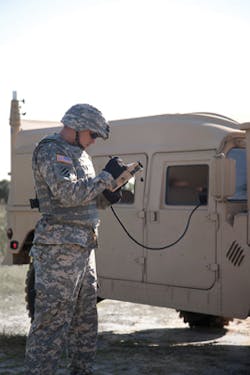Leonardo DRS to provide rugged computers for military networked battle
SCOTT AIR FORCE BASE, Ill. — U.S. military battlefield computing experts needed a modular family of rugged computers that integrates networked battle command information system capabilities onto a common computing platform. They found their solution from Leonardo DRS Network & Imaging Systems LLC in Melbourne, Fla.
Officials of the Defense Information Technology Contracting Organization at Scott Air Force Base, Ill., announced a potential $841.5 million contract to Leonardo DRS for the Mounted Family of Computer Systems (MFoCS) II program.
MFoCS integrates Force XXI Battle Command Brigade-and-Below and Joint Battle Command-Platform (JBC-P) capabilities into a common computing system. The MFoCS II program primarily is in response to U.S. Army battlefield computing requirements.
DRS Network & Imaging Systems a modular family of rugged computers to the military to integrate networked command information onto a common computing platform.
MFoCS supports situational awareness, command and control, and maneuver capability with next-generation rugged computers and displays that several different configurable levels. Systems include ruggedized tablet computers, processors, keyboards, removable solid-state disks, displays, and cabling.
This contract to Leonardo DRS is for computer hardware and services for full-rate production, fielding, and replacement requirements to meet JBC-P program requirements. DRS is the original MFoCS contractor.
JBC-P consists of ultra-rugged computers, software, and Suite B encryption security that enables warfighters to send and receive friendly force position location.
It JBC-P essentially is a follow-on to, or advanced component of, the Army’s Force XXI Battle Command Brigade and Below (FBCB2) program, and will be interoperable with the current FBCB2 Blue Force Tracking (BFT) system.
The FBCB2 provides battlefield situational awareness to enable fast, well-informed decisions. The JBC-P is expected to enhance FBCB2 performance, and reduce the risk of fratricide.
For the remainder of this decade and into the 2020s, MFoCS is designed to push the leading edge of technology from inception to retirement in combat computing, whether in compliance with the Army’s VICTORY (Vehicular Integration for C4ISR/EW Interoperability) initiative, security, or ruggedization.
The Army awarded the MFoCS contract to DRS in 2013 in a potential $455 million deal. The contract calls for DRS to build a variety of vehicle-mounted command, control, communications, computers, intelligence, surveillance, and reconnaissance (C4ISR) equipment.
The foundational element of the MFoCS program is the rugged tablet that warfighters can mount in combat vehicles, as well as disconnect the tablets and continue using them while operating on foot. This enables warfighters in vehicles to share what they are seeing on their screens with warfighters operating on foot.
Battlefield commanders can work on a tablet in a combat vehicle, and then take the computer into a command post and dock it.
Leonardo DRS will receive a minimum of $5 million, and will fulfill task orders collectively worth as much as $841.5 million. On this contract Leonardo DRS will do the work in Melbourne, Fla., and should be finished by May 2024.
For more information contact Leonardo DRS online at www.leonardodrs.com, or the Defense Information Technology Contracting Organization at www.disa.mil/Mission-Support/Contracting.

